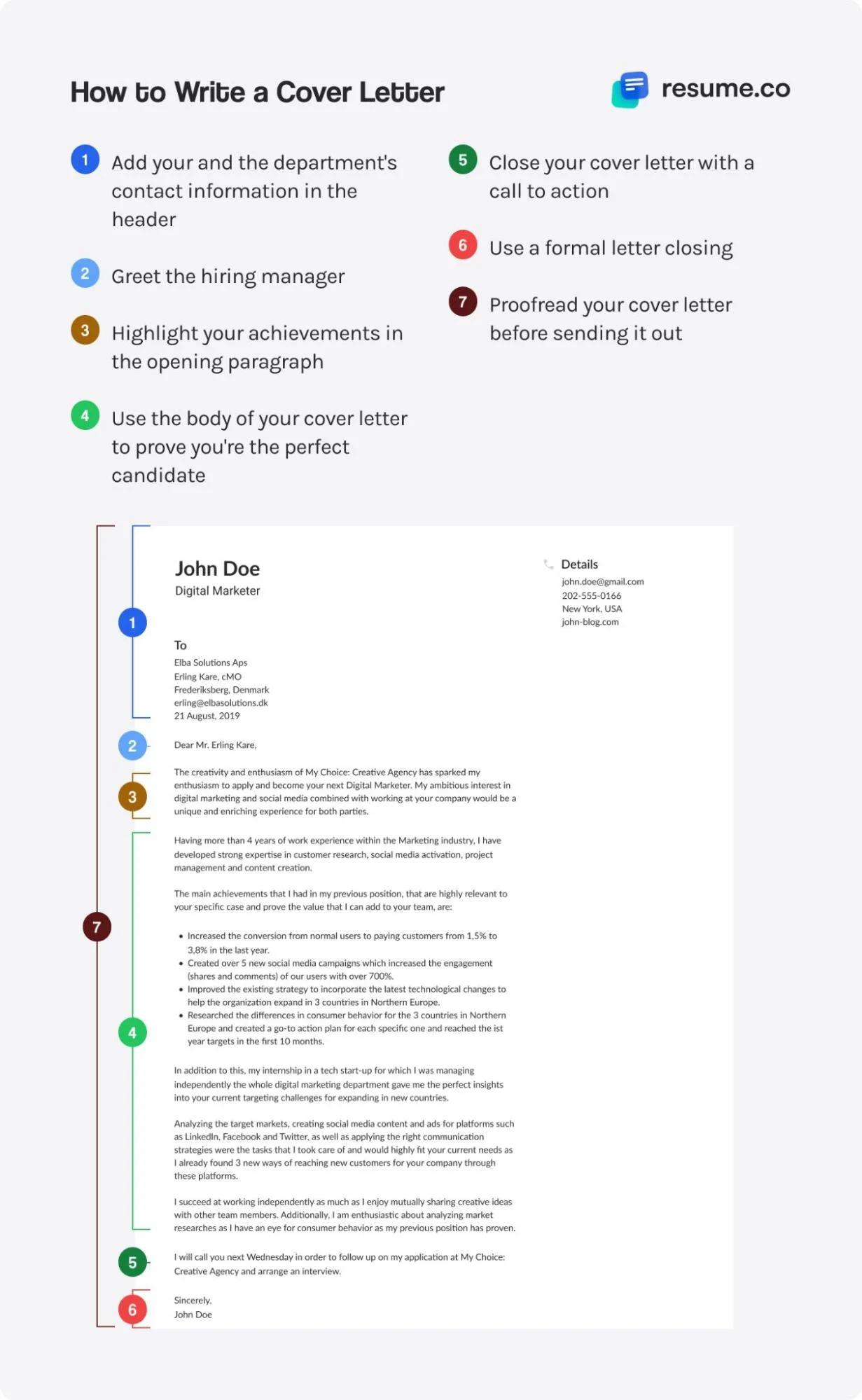As an aspiring recruiter, you understand better than most how finding the right candidate can impact a company’s future. Therefore, you probably know that a recruiter cover letter has the potential to set you apart from other applicants and give you an edge in the hiring process.
On the other hand, it will be easier for you than for most to see yourself from a recruiter’s point of view, so why not use such insight to craft an impressive additional document for your job application?
Join us on a journey to write a recruiting cover letter that captivates your fellow recruiter’s attention and positions you as a top candidate.
Key Takeaways
The format and layout of your cover letter are just as important as its content.
The first paragraph of your cover letter is crucial for getting the hiring manager’s attention, so make sure it is engaging.
Your skills, qualifications, and experiences that are most relevant to the position you’re applying for should be highlighted.
You should express motivation for the role by highlighting your compatibility with the company’s values and culture.
What Format to Use For Recruiter Cover Letter
A recruiter cover letter should be based on a standard business letter format. If the layout and format aren’t right, the hiring managers probably won’t bother considering it at all.
Here’s a concise overview of what your recruiter cover letter should look like:
Cover Letter Format
Put complete contact information as well as the contact information of the person you’re addressing the letter to in the header of your cover letter.
Start with a formal greeting that goes below the header and serves as an opening to the letter.
Include three to four paragraphs that cover your experience, skills, and motivation in the body of the cover letter, and wrap it up with a call to action.
Close the cover letter formally and add a postscript if you want to highlight a particular detail about your competence and experience.
Ensure that the length of the letter is between 200 and 400 words.
Use a standard font type (10–12 pt) to ensure your recruiter cover letter is easy to read.
Keep the margins set to 1 inch on all sides, and the line spacing should be 1.0.
To get a clearer picture of what the letter should look like, here’s a recruiter cover letter sample:

Recruiter Cover Letter Structure
Now that we’ve covered the recruiter letter format and layout, let’s learn how to write each section in the best way.
#1. Heading
Hiring managers will look at the heading first, so make sure all the necessary information is included. These are:
Header Mandatory Details
Your name
Professional title
Phone number
Email address
Relevant social media links (optional)
Date of writing
You should also put the recipient’s contact information below yours. Ideally, you’ll know the hiring manager’s name, but if you don’t, put your research skills to action and do your best to find it. Such specifics highlight how committed and motivated you are.
Here’s an example of how the header should look like:
Good Example
Megan Racey Recruiter 2003 Jenson Street 715-394-8434 meganracey@example.com San Diego 07/09/2023 Helen Doucher Hiring Manager X Company 2922 Holt Street San Diego
#2. Greeting
The most important thing in this part is to avoid generic phrases like “To whom it may concern.” Start in a simple and formal tone and use the recipient’s name. In case you don’t know the name, use their job title or Mr./Ms. instead.
Here’s an example of a cover letter greeting:
Good Example
Dear Ms. Doucher,
#3. Introduction
The main purpose of the recruiting cover letter introduction is to capture the hiring manager’s attention so that they read the whole letter. To achieve such an effect, highlight some of your most relevant achievements, experiences, or skills within the first couple of sentences.
Here’s an example:
Good Example
I am writing to express my strong interest in the recruiter role at your company. As a professional recruiter with seven years of experience, I have successfully hired over 700 employees with a 95% five-year retention rate. I use data-driven insights to find ideal candidates for the company because I am aware of the impact a good hire can have on its future.
Take note of how this candidate describes their work style while also putting their accomplishments in quantifiable terms.
#4. Skills, Qualifications, & Experiences
The most important thing to focus on when writing the body of your cover letter is the skills and experiences that align best with the job you’re applying for. This paragraph should include your most valuable assets, but make sure to properly highlight those that are most relevant to your desired job position.
It is essential that you research the company you’re applying for, its culture, expectations, and all the specifics related to the job you want to apply for. Write a compelling narrative that demonstrates how your experiences and qualifications meet the needs of the organization rather than just listing them.
One of the best ways to demonstrate your competence and establish credibility is to provide numerical examples of your work's success.
Here’s an example:
Good Example
During my work at [name of the company], I have implemented a plan to improve employee retention, cutting turnover by 23% within two years and streamlining the recruiting procedure from nine stages to five. New hires reported a 95% satisfaction rating for the new onboarding procedure I developed, and overall employee satisfaction increased by 18%.
#5. Why You’re Applying For This Position
In the previous paragraph, you explained how and why you are a great fit for the company. In this one, you need to convince the hiring manager that you are applying out of genuine interest and not just because you need a job.
You’ll do this by expressing what you admire about the company you’re applying to. This is where your research skills also come in handy, especially if you don’t really know that much about the company. The point is to highlight how your values align with the company’s.
Here’s an example:
Good Example
What I find particularly appealing about working for the [name of the company] is its uncompromising ethics and positive work culture that encourage professional growth and development. I am confident that my knowledge and experience would contribute to the development of the company, and I am excited by the prospect of taking on the many challenges that come with working for an organization of this size and standing.
#6. Call to Action
To wrap up your recruiting cover letter with impact, it is essential to conclude it with a compelling call to action. You can achieve that by extending your gratitude to the hiring manager for taking the time to review your application and conveying your eagerness to discuss your qualifications further.
This proactive step demonstrates your enthusiasm for the role and sets the stage for the next step in the hiring process.
So, let’s see what this looks like in practice:
Good Example
Thank you for taking the time to review my cover letter and resume and consider my application. I look forward to hearing from you and discussing how my qualifications align with the job requirements.
#7. Closure & Sign Off
Your cover letter's final section should follow the same formula as the introduction, meaning it should be formal and simple.
Here’s an example:
Good Example
Sincerely,
Megan Racey
Take a look at this complete recruiting cover letter example that might come in handy when writing your own.
5 Tips for Creating a Recruiter Cover Letter
Let’s round off with a couple more expert tips to fine-tune your recruiter cover letter and ensure it stands out:
Tips for Writing a Recruiter Cover Letter
Highlight relevant hard skills. Although the HR industry typically places a high value on soft skills, having particular hard skills is still advantageous. Knowing how to use certain tools can give you an edge in the current job market, especially given the ongoing automation of HR processes.
Use keywords. Many companies today use automated resume screening tools which are based on keyword recognition. Therefore, it is essential to research and include the relevant keywords in your recruiter resume and cover letter.
Highlight your abilities. If you’re writing a recruiter cover letter with no experience and are stressing over it because you don’t have any experience to show, don’t worry. You can achieve the same effect by highlighting your relevant skills, volunteer experiences, internships, and similar engagements.
Proofread your professional recruiter cover letter. If you have enough time, sleep on the letter before sending it. Then, read it carefully again with fresh eyes and ensure you leave no typos and similar mistakes uncorrected.
Tailor your cover letter to each position you’re applying for. It is not the same if you’re writing a hiring manager cover letter, corporate recruiter cover letter, or technical recruiter cover letter.
Final Thoughts
Now that we have reached the end of this guide, you should keep in mind that your cover letter is more than just words on paper. It is the first step toward a successful professional life.
Think of it as an extension of your recruiter resume and a chance to establish the first of many connections with the company you are applying to. After all, if anyone can understand a hiring manager, that’s a recruiter, so use this insight as an advantage in your job pursuit.
Additionally, you can further prepare by reading common recruiter interview questions—this will help you anticipate what concerns and priorities might come up and tailor your cover letter accordingly.
So, may your recruiter cover letter be as sharp as your instincts and as strong as your desire to excel in HR. Best of luck in your career endeavors!
Related Articles
Operations Manager Cover Letter & Writing Guide


